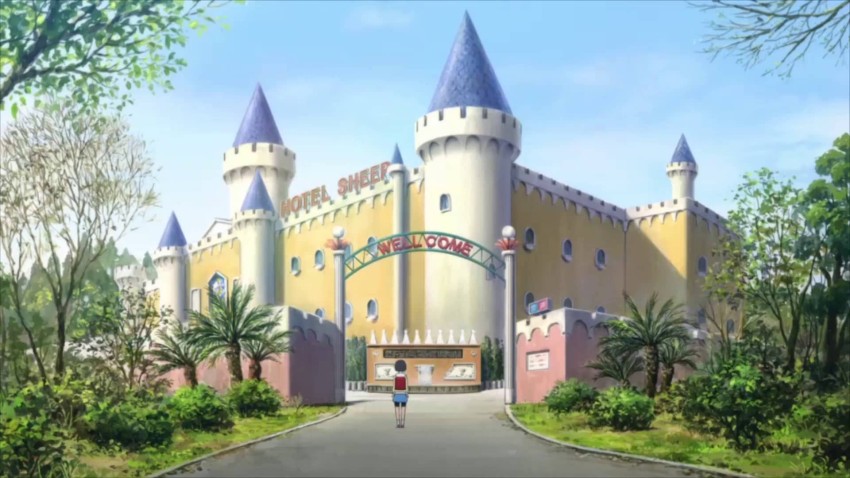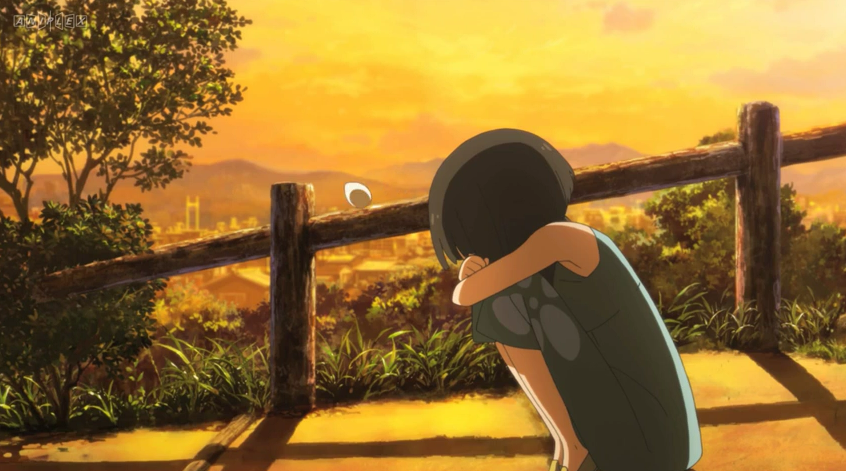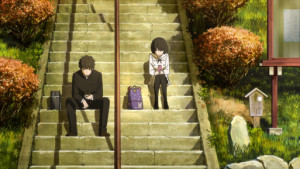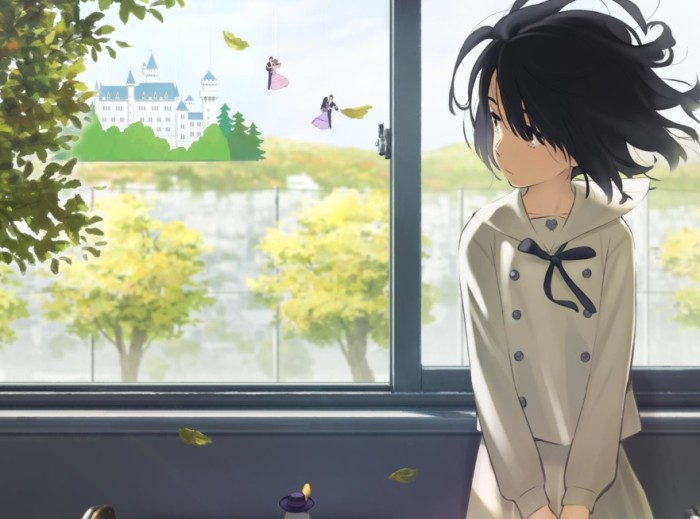Anthem of the Heart
February 11, 2016 · 0 comments
By Andrew Osmond.
 “In the twenty-first century,” notes the Anime Encyclopedia, “it became apparent that the last frontier for modern Japanese animation might be the real world itself, with a deep sense of ready nostalgia for hazy school days, mawkish classroom flirting, or the exotic appeal of old-fashioned friendships and hobbies.” Anthem of the Heart may not be the perfect exemplar of “Everyday Anime,” as the Encyclopedia calls it. Some things in Anthem’s story are definitely not everyday life. But Anthem’s heart, its currency, is its conversion of daily school life, or older viewers’ fond memories of that life, into brighter, better, purer anime form.
“In the twenty-first century,” notes the Anime Encyclopedia, “it became apparent that the last frontier for modern Japanese animation might be the real world itself, with a deep sense of ready nostalgia for hazy school days, mawkish classroom flirting, or the exotic appeal of old-fashioned friendships and hobbies.” Anthem of the Heart may not be the perfect exemplar of “Everyday Anime,” as the Encyclopedia calls it. Some things in Anthem’s story are definitely not everyday life. But Anthem’s heart, its currency, is its conversion of daily school life, or older viewers’ fond memories of that life, into brighter, better, purer anime form.
Like much twenty-first century anime, though, Anthem of the Heart slyly stirs in a bit of fantasy. In the pre-title prologue, little Jun, an energetic chatterbox, is investigating the castle on the hill above her modern-day town. Suddenly she’s thrilled to glimpse her dad in a car driving out of it (though Jun imagines him riding a noble horse out of a picture book). He’s accompanied by a strange woman. Japanese viewers – at least those older than poor Jun – will pick up on the ghastly truth quicker than foreigners. The “castle” is actually a love hotel, where couples steal away for sex. You can guess Jun’s mum’s reaction when she hears the news.
In short order, Jun’s parents are separating; her mum gets custody, and her dad’s last bitter words to Jun are to tell her it’s all her fault. Devastated, Jun is alone on the hillside when she has a “supernatural” meeting with a talking egg. Like a good fairy-tale demon, this round critter teases, taunts and curses her, zippering up her mouth. Like several recent anime, we’re left to wonder if this encounter is real or a child’s fantasy coping mechanism. Anything can happen in anime, and anything can equally happen in the imagination.
 Everything we’ve described happens in the opening minutes, before the main story commences a few years later. Jun is now a high-schooler, so silent and withdrawn that her classmates presume she’s mute. But then, shockingly, her teacher picks Jun to help organise the next community outreach performance for her neighbourhood. Her strangulated protest only gives away the fact she can speak. Eventually she learns to communicate through mobile text messages, which another film might use to make Jun seem strange, even alien. Here, though, it’s a sweet, plaintive device, especially as we know there’s a bubbly, passionate girl trapped in her self-imposed shell.
Everything we’ve described happens in the opening minutes, before the main story commences a few years later. Jun is now a high-schooler, so silent and withdrawn that her classmates presume she’s mute. But then, shockingly, her teacher picks Jun to help organise the next community outreach performance for her neighbourhood. Her strangulated protest only gives away the fact she can speak. Eventually she learns to communicate through mobile text messages, which another film might use to make Jun seem strange, even alien. Here, though, it’s a sweet, plaintive device, especially as we know there’s a bubbly, passionate girl trapped in her self-imposed shell.
Thanks to her teacher, Jun is thrown together with three virtual strangers. Natsuki is a cheerleader; Daiki is a former baseball ace, seething with frustration at the busted elbow which threw him out of the game. And then there’s Takumi, a soft-spoken lad with a creative streak. Jun hears him singing a silly song about eggs, and the whimsy somehow touches her heart, the dreamer she used to be. Then their teacher suggests they put on a musical…
Anthem of the Heart unites a famed trio who’ve worked together before: writer Mari Okada, director Tatsuyuki Nagai and character designer/animation director Masayoshi Tanaka. All three were celebrated for their work on a 2011 TV serial, Anohana: The Flower We Saw That Day, retold as an anime cinema film in 2013. Like Anthem, Anohana is a mix of ‘real’ life and ambiguous fantasy, depicting five youngsters who tragically lost their childhood playmate – who now haunts one of the survivors as an indelible memory or an actual ghost.
 Anthem has a separate story and characters from Anohana, but there are myriad points of stylistic continuity, as well as a common backdrop. Both anime take place in Chichibu, a city ninety minutes from Tokyo by train (and the original inspiration for The Mikado’s Titipu). According to an article on the Asashi Shimbun website (translated from the Anime Anime Japan website), in the six months after Anohana’s broadcast, eighty thousand anime fans visited the city, benefiting the local economy by over $3 million. This would make Anohana one of the most successful anime “holy lands” – the label for locations represented in anime which encourage fans to visit the real places. An Anohana festival, featuring voice-actors from the anime, was held to launch the film in 2013, while Anthem was announced at the city’s Night Festival in the following year.
Anthem has a separate story and characters from Anohana, but there are myriad points of stylistic continuity, as well as a common backdrop. Both anime take place in Chichibu, a city ninety minutes from Tokyo by train (and the original inspiration for The Mikado’s Titipu). According to an article on the Asashi Shimbun website (translated from the Anime Anime Japan website), in the six months after Anohana’s broadcast, eighty thousand anime fans visited the city, benefiting the local economy by over $3 million. This would make Anohana one of the most successful anime “holy lands” – the label for locations represented in anime which encourage fans to visit the real places. An Anohana festival, featuring voice-actors from the anime, was held to launch the film in 2013, while Anthem was announced at the city’s Night Festival in the following year.
As in many anime, Anthem’s location serves as a character in its own right, giving a solid grounding to the youngsters’ lives; for example, the dark station platform where two of the students meet unexpectedly one evening, or the hills and fields where little Jun plays before the bad thing happens. Chichibu is also the birthplace of the woman writer Mari Okada, who’s the best known of Anthem’s team. Okada is enormously prolific; as well as scripting the whole of Anohana, her “series composition” credits include Vampire Knight, Black Butler, Lupin the Third: The Woman Called Fujiko Mine, Gosick, Fractale, Hanasaku Iroha and A Lull in the Sea. As of writing, her latest title is the new TV iteration of the Gundam franchise, subtitled Iron-Blood Orphans.
Anohana and Anthem director Tatsuyuki Nagai is now directing Orphans, having previously directed the comedy-drama anime Waiting in the Summer. Like Anthem, this revolved around a group of school-age youngsters trying to put on a “performance” – an amateur movie rather than a musical – while some conceal terrible secrets or secretly love characters who love other people in turn. Anthem’s character designer/animation director Masayoshi Tanaka worked with Nagai on Waiting in the Summer, as well as designing the characters for the very different High School of the Dead, and contributing animation to everything from Chobits to Eureka 7.
 While Anohana is usually counted as the obvious precursor to Anthem of the Heart, it’s worth noting the three main creators – Okada, Nagai and Tanaka – had previously united on Toradora!, an excellent school romcom series broadcast in 2008. It’s a far broader comedy than Anthem, but the show is punctuated by emotional crises and climaxes while its characters become steadily deeper. However, Toradora! doesn’t look much like Anthem. The missing ingredient is the A-1 Pictures studio, which has been turning out anime, often outstandingly colourful and attractive, since it opened in 2005. As well as Anthem and Anohana, A-1 handles the Black Butler, Blue Exorcist and Sword Art Online franchises, as well as Fairy Tail, Magi and more unusual titles such as the novelistic future saga From the New World.
While Anohana is usually counted as the obvious precursor to Anthem of the Heart, it’s worth noting the three main creators – Okada, Nagai and Tanaka – had previously united on Toradora!, an excellent school romcom series broadcast in 2008. It’s a far broader comedy than Anthem, but the show is punctuated by emotional crises and climaxes while its characters become steadily deeper. However, Toradora! doesn’t look much like Anthem. The missing ingredient is the A-1 Pictures studio, which has been turning out anime, often outstandingly colourful and attractive, since it opened in 2005. As well as Anthem and Anohana, A-1 handles the Black Butler, Blue Exorcist and Sword Art Online franchises, as well as Fairy Tail, Magi and more unusual titles such as the novelistic future saga From the New World.
But as we suggested above, you can also see Anthem as part of a broader anime trend toward small “realistic” stories of school life. Anthem has more plot and higher emotional stakes than some anime classed as slice of life, but fittingly its English name recalls Whisper of the Heart, one of the earliest cinema entries in this sub-genre. Produced by Studio Ghibli, Whisper also had high-schoolers who get fired up creatively; a male protagonist with an unexpected musical ability; the appearance of familiar Western tunes (Anthem offers “Over the Rainbow” and the English folk song “Greensleeves”); and confused tangles about who loves who. You could also compare Anthem to Keiichi Hara’s film Colorful, which also has an unwitting child spotting secretive couples at a love hotel, and a ‘magic’ character who might be the defence mechanism of an imagination in trauma.
Anthem of the Heart is released in the UK on 26th June as a Zavvi exclusive.
Leave a Reply